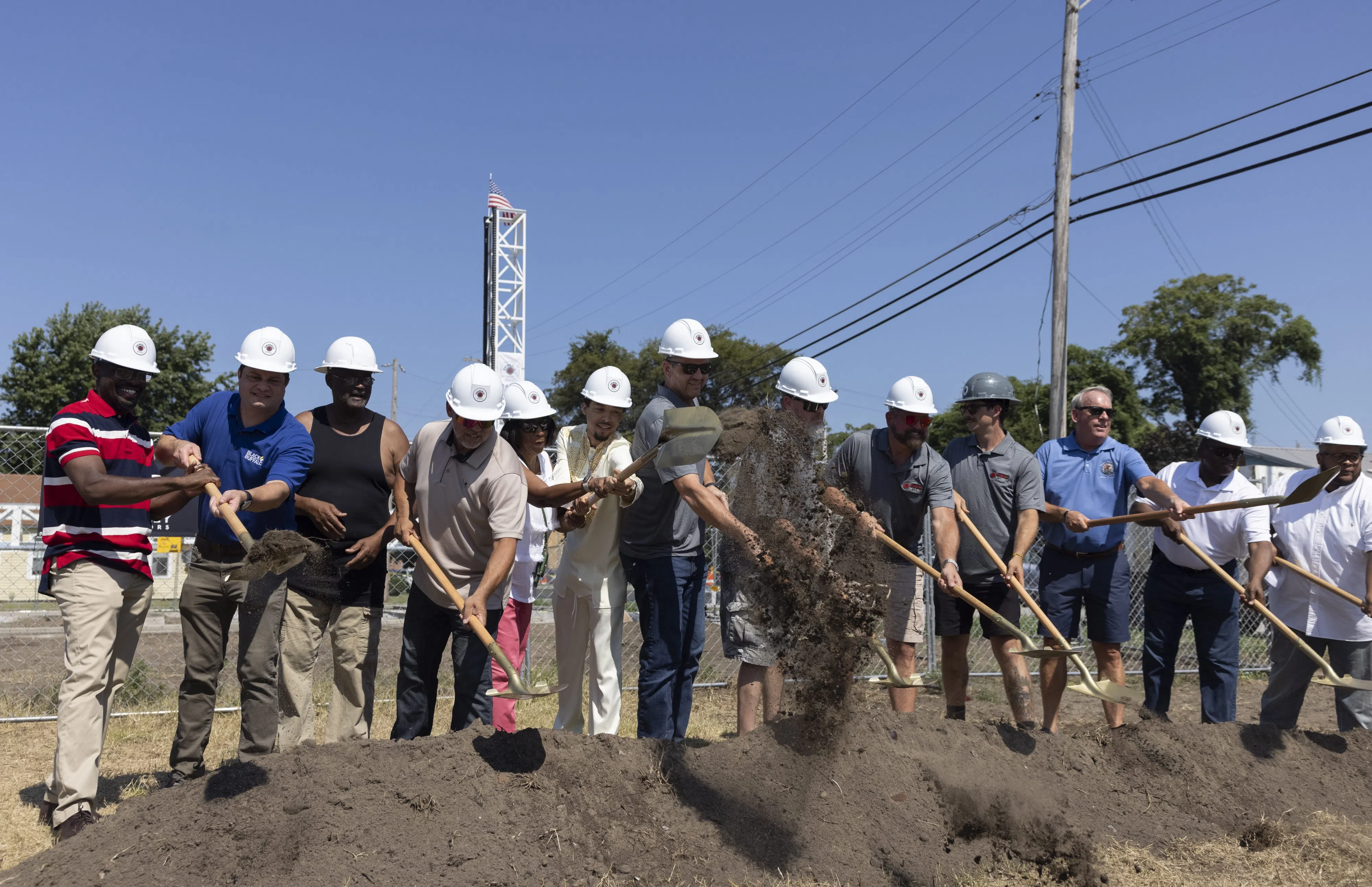Machine to build first new home in Illinois’ southernmost city in 50 years
By MOLLY PARKER
Capitol News Illinois
mparker@capitolnewsillinois.com
CAIRO – A massive 12-ton 3D printer has arrived in Cairo to construct a duplex on vacant land behind the town’s city hall. The towering gantry system stretches into the sky as the machine, guided by a computer rendering, layers a specialty concrete mix like toothpaste squeezed from a tube.
Hundreds gathered in Illinois’ southernmost city on Saturday to witness a demonstration of the futuristic printer, with American flags waving from the top of its two tall legs. 3D printing is emerging as a promising technology that could accelerate affordable housing development nationwide. The machine, the first of its kind in the region, is owned by Eminence Resource Inc., based in Harrisburg, 80 miles north of Cairo. The company is donating the duplex to the city.
For this town of roughly 1,600 people, the 3D-printed duplex represents a hard-fought victory for affordable housing, years in the making. This is Cairo’s first new home construction in nearly 50 years.
The town has been grappling with how to replace some of the affordable housing lost when the federal government demolished two family public housing complexes, Elmwood and McBride, in 2019. Nearly 400 residents were displaced. A few years earlier, the U.S. Department of Housing and Urban Development had taken the rare step of seizing control of the Alexander County Housing Authority from local officials, citing severe mismanagement and unsafe living conditions.
HUD officials argued that the buildings were too dilapidated to repair. Although displaced residents were given rental vouchers to help subsidize their rent in the private market, many had to move more than 30 miles away due to a lack of affordable housing in Cairo.
“What’s really cool about this is the first two families who get to move into this amazing duplex are going to be some of the first families who were displaced from the housing crisis of the Elmwood and McBride demolition,” said State Sen. Dale Fowler, R-Harrisburg, whose district covers the region, and who helped connect Eminence managers and Cairo city officials.
“We’ve got people – they’re ready to come home, and I don’t blame them,” added Cairo Mayor Thomas Simpson, to cheers from the crowd. The city is taking applications from former Elmwood and McBride residents for the homes but hasn’t said yet who will move into them.
When Cairo tried to replace some of the affordable housing the town had lost, it encountered the same challenges that many rural towns and distressed urban areas face. Many rural towns still operate public housing apartment complexes, but when they fall into disrepair, there’s few options to replace them.
In the 1970s, the federal government shifted its affordable housing strategy, moving away from direct funding for public housing construction toward public-private partnerships. This approach included providing vouchers to pay a portion of tenants’ rent in the private market, but that is not much help to communities with a shortage of private-market rentals.
When new affordable housing apartment complexes are constructed, they are typically built by private developers and nonprofits using complex tax-credit deals that are also difficult to make work in smaller communities where projects often can’t reach the scale or rental price point needed to be profitable.
In Cairo, housing for children and their parents is a critical need. State data shows that more than one in five children in Cairo’s pre-K district are considered homeless, under a broad definition that includes kids who are unhoused, doubled up with friends or relatives, couch-surfing, or living in hotels and other temporary accommodations.
Though the addition of two new housing units does not solve the breadth of the city’s housing crisis, Simpson said city officials are working on plans to fund the development of additional housing on the same lot.
“Folks, this is just the beginning,” he told the crowd Saturday.
It is expected to take the 3D printer about 45 hours to construct the duplex’s interior and exterior walls, with crews working through the night over the next two weeks to complete the job. Several more weeks will be needed for finishing work, including hanging drywall, installing plumbing, electricity, flooring, and other interior elements like kitchen and bathroom fixtures, to make the home move-in ready.
Eminence purchased the printer from Black Buffalo 3D and it was delivered from a warehouse in New Jersey in parts by three semitrailers to Cairo. This project is the inaugural use of the machine at its new southern Illinois location, though Josh Burtis, the general manager of Eminence, said it will soon go to work building homes across southern Illinois. Burtis said his company purchased the printer in response to the growing need for affordable housing in the region. While it can take months to build a home using traditional construction methods, 3D printers can do it in a matter of weeks.
“Our goal by bringing this technology here is showcasing that, hey, we’re here to work. We want to build houses, more resilient homes, fast as we can put them up and put people back in housing here,” Burtis said. “Because the more housing we get, the more people we get here – that keeps building these communities back, and that’s our main goal, to build affordable workforce housing and just keep growing these communities back.”
Capitol News Illinois is a nonprofit, nonpartisan news service covering state government. It is distributed to hundreds of newspapers, radio and TV stations statewide. It is funded primarily by the Illinois Press Foundation and the Robert R. McCormick Foundation, along with major contributions from the Illinois Broadcasters Foundation and Southern Illinois Editorial Association.


